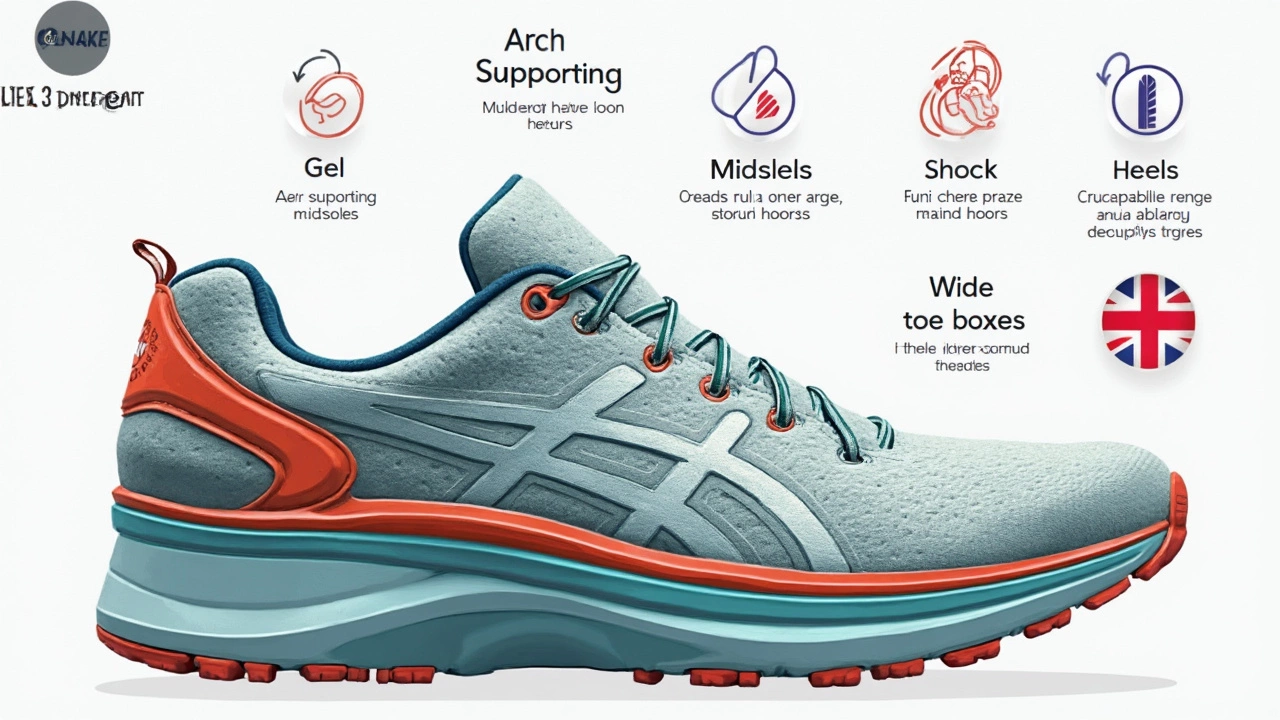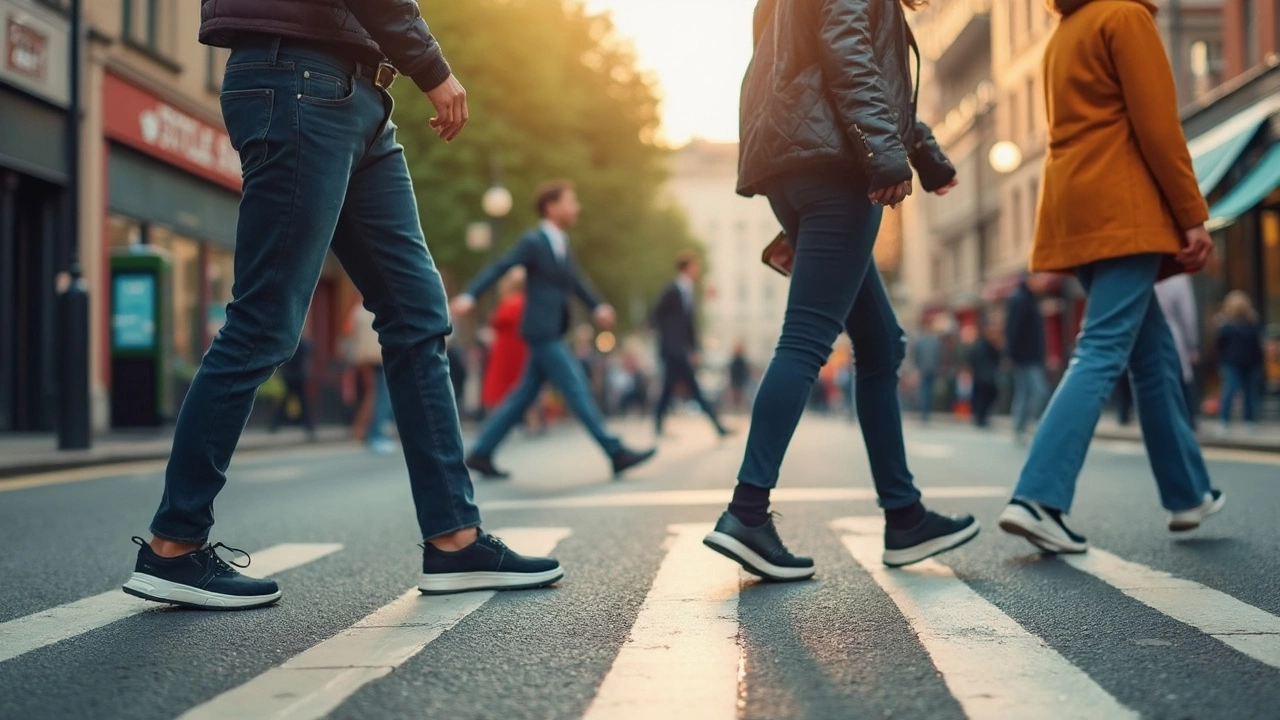If you’re standing for eight, ten, or maybe even twelve hours at work, your feet can easily turn from your best friend to your worst enemy. Ever see those videos of chefs or nurses peeling off their shoes at the end of a shift? That’s real pain right there—and it’s usually because their shoes let them down.
Here’s the thing: comfort isn’t just about feeling good in the moment. Wearing the wrong shoe can mess with your knees, back, and even your mood before lunch. Blisters, hot spots, aching arches—all of that adds up fast. And no, those fancy sneakers that look amazing don’t always cut it in the real world of hard floors and long hours on your feet.
So what actually works? Forget the hype and Instagram ads. It’s all about support, fit, and smart features—not just a soft sole. Some jobs need slip resistance, others need a steel toe, but every job needs a shoe that fits your foot and supports your style of working.
- What Really Matters in an All-Day Work Shoe?
- Key Features You Shouldn't Ignore
- Best Shoe Picks for Different Jobs
- Tips to Make Standing Easier
What Really Matters in an All-Day Work Shoe?
When you’re clocking long shifts on your feet, little details in your shoes can either save the day or ruin it. The top thing to keep in mind is support. That doesn't mean just arch support or heel cups, but how the whole shoe keeps you stable and comfy hour after hour. If your feet roll inward or outward (overpronation or supination), you need a shoe that helps with that. A bad fit puts more pressure on joints, which is why, according to a survey by the American Podiatric Medical Association, almost 77% of people say foot pain messes with their daily lives. That’s a huge chunk of folks just wishing their shoes had done better.
Every job is a little different, but some stuff matters no matter what you do. Here’s what you really want in a best work shoe for all-day standing:
- Good arch support: You shouldn’t feel like your arch is collapsing. Shoes that hug your foot’s shape take a lot of stress off your muscles.
- Cushioning: Memory foam feels nice for the first hour, but dense foam or gel padding that keeps shape under pressure is what actually helps long-term.
- Right width: If the shoe squeezes or swims on your foot, it’s going to cause blisters or soreness. Lots of brands now have wide or extra-wide options—don’t settle for the wrong fit.
- Breathability: If your feet get hot and sweaty, you’re going to be miserable. Mesh panels or moisture-wicking liners really do help, especially in warm settings.
- Grip: Slippery floors send more people to the ER than you’d think. Look for outsoles labeled "slip resistant" if that’s even a remote risk at your job.
Take a look at this snapshot of what matters most, pulled from workers who stood for at least 8 hours daily:
| Feature | % Who Said It's Essential |
|---|---|
| Arch Support | 82% |
| Cushioning | 77% |
| Slip Resistance | 63% |
| Width Options | 54% |
| Breathability | 48% |
Basically, don’t settle for a soft insole and call it a day. Fit, stability, and proven support are what will actually help you get through those marathon shifts.
Key Features You Shouldn't Ignore
Finding the best work shoes for standing all day isn’t about style—it’s all about function. Here’s what separates the shoes you grab for a marathon day from those you leave at the back of the closet.
Supportive Insoles: Look for shoes with thick, cushioned insoles or good arch support. A flat shoe with zero padding will leave your feet screaming, especially if you’re on hard floors. Removable insoles are even better, so you can swap them out or upgrade when needed.
Shock Absorption: Cement floors don’t have any give, so decent shock absorption is a must. Midsoles made from materials like EVA foam or memory foam help keep each step from rattling up your legs.
Good Fit and Width: Sizing isn’t just about length. If your shoes are too tight or too loose, you’ll be rubbing blisters by noon. Many brands now offer wide and extra-wide options, so don’t settle for a shoe that pinches or squishes your feet.
Breathable Materials: Nobody likes sweaty feet. Mesh panels or moisture-wicking materials keep things cool and help prevent that end-of-day stink. Leather can be good for durability, but make sure it’s not trapping all the heat in.
Non-Slip Outsoles: This one’s key for everyone from restaurant folks to hospital workers. A non-slip or oil-resistant outsole can keep you on your feet literally, not just metaphorically. Look for a patterned tread rather than a smooth sole.
- Extra toe protection if you work around heavy stuff (think composite or steel toe).
- Easy to clean? Big bonus if you’re in messy environments like kitchens or workshops.
- Lightweight construction to keep you from feeling like you’ve strapped bricks to your feet.
Bottom line: When you’re shopping for work shoes, these features aren’t extras—they’re must-haves. They’re the difference between feeling okay after a long shift and hobbling home with sore, tired feet.

Best Shoe Picks for Different Jobs
Let's be honest, not every shoe is built for every job. What works for a hospital doesn’t always work for a factory or a classroom. Here’s a breakdown of what actually fits for a handful of real jobs where people are on their feet nonstop.
- Healthcare (Nurses, Doctors, Techs): Nurses log around 4 to 5 miles on a typical 12-hour shift. That’s no joke. The Hoka One One Bondi and Brooks Ghost are big favorites in hospitals. These shoes cushion insanely well, stand up to disinfectants, and have solid arch support.
- Restaurant and Retail Workers: Slippery floors and long shifts call for non-slip soles. Shoes For Crews and Skechers Work series are known for their grippy bottoms. The Skechers Work Sure Track is especially popular because it handles spills and keeps feet supported for a whole dinner rush or a 10-hour Black Friday shift.
- Warehouse, Delivery, and Trades: If you lift, climb, or push stuff all day, you need more protection and durability. Keen Utility’s Atlanta Cool and Timberland PRO series both have slip resistance and sturdy toe protection. These shoes are waterproof too, so no soggy socks if you’re doing a truck unload in the rain.
- Teachers and Office Staff: You wouldn’t think these folks walk a lot, but some clock 7,000 steps before lunch. Rockport and Clarks Unstructured lines bring dress shoe looks with sneaker comfort. The Rockport Men's Eureka and Clarks Women's Sillian Bella keep feet happy during parent meetings and playground duty.
If you want some numbers, here’s how some of these best work shoes match up head-to-head:
| Shoe Model | Arch Support | Slip Resistance | Toe Protection | Cushion |
|---|---|---|---|---|
| Hoka One One Bondi | Excellent | Good | No | Maximum |
| Skechers Work Sure Track | Moderate | Excellent | No | High |
| Keen Utility Atlanta Cool | Good | Excellent | Yes (Steel/Composite) | Moderate |
| Rockport Eureka | Moderate | Good | No | High |
So, next time you’re shoe shopping for work, think about what your day actually looks like. Don’t just trust what your friends like—match the shoe to the beatdown your feet take most.
Tips to Make Standing Easier
Even the best work shoes can use a little help if you're clocking in long hours on your feet. It’s less about just buying the flashiest pair and more about taking some smart steps every day.
- Rotate Your Shoes: Wearing the same pair nonstop messes with your feet. Try switching shoes every day if you have the option. It lets the cushioning bounce back and reduces wear in the same spots.
- Use Insoles That Actually Work: Standing all day puts crazy pressure on your heels and arches. A 2023 worker health survey found that people using custom or over-the-counter arch supports reported less fatigue and up to 60% fewer complaints of sore feet at day’s end.
- Don’t Ignore Socks: All socks are not created equal. Compression socks, in particular, can help with blood flow and swelling. Try a moisture-wicking pair to keep things cool and dry.
- Stand on Mats When Possible: Hard floors are brutal. Anti-fatigue mats can cut foot pain by about 40%, especially for folks doing a lot of stationary work, like cashiers or assembly line workers.
- Take Micro-Breaks: Can’t sit? Just shifting your weight or rolling onto your toes for a few seconds helps keep things moving. Even five-minute breaks every hour can ease lower back and leg strain.
- Stretch—A Lot: Stretching your calves, ankles, and lower back at breaks lowers the risk of long-term pain. Just a minute a couple times a shift makes a difference.
| Tip | How Much It Helps |
|---|---|
| Custom insoles | Reduces reported foot soreness by up to 60% |
| Anti-fatigue mats | Cuts foot pain by about 40% |
| Compression socks | Helps with swelling and keeps feet dry |
One last thing? Pay attention to any signals from your body. Tingling, numbness, or sharp pain probably means it’s time to try something different—don’t try and tough it out. Your feet do more for you than any tool in your kit.
